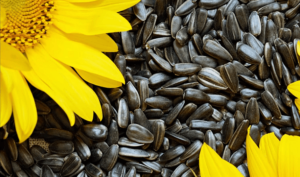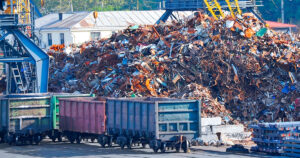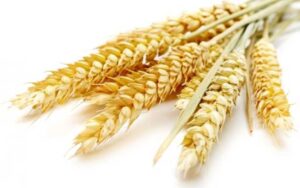
Ukraine in January 2024 exported the largest volume of goods since the start of the full-scale invasion – 12 million tons of products, including 8.7 million tons exported by sea, the Economy Ministry said on Monday.
“We are very close to reaching pre-war physical export volumes. In January 2024, Ukraine exported 12 million tons of products. This is only 2 million tons less than in pre-war January 2022,” First Deputy Prime Minister and Minister of Economy Yulia Svyrydenko was quoted as saying in the release.
Earlier, Taras Kachka, Deputy Minister of Economy and Trade Representative of Ukraine, told Interfax-Ukraine that in December 2023, Ukraine reached the 10 million tons export figure, which was last reached in March 2023, followed by a decline in exports to less than $3 billion a month due to Russia’s disruption of the grain corridor.
Svyrydenko added that in January, the first vessel insured against military risks under the UNITY insurance was loaded in the ports of Greater Odesa. The cost of insurance for this vessel was 0.75% of the vessel’s value, which is much cheaper than during the Black Sea Grain Initiative.
The head of the Ministry of Economy believes that the normalization of the insurance market in trade is a cornerstone element of the resumption of exports of value-added products, and the goal is to reach not only pre-war export volumes but also higher revenues, which will be facilitated by the free shipment of Ukrainian containers by sea.
“This will only be possible when the insurance market for maritime transportation recovers. That is why it is so important for us that insurance becomes more affordable and is actually used to export Ukrainian products,” the First Deputy Prime Minister said.
The Unity ship insurance program, which the Ukrainian government is implementing jointly with Marsh McLennan and a pool of insurance companies led by ASCOT, is designed to reduce the cost of insurance for the maritime transportation of grain and other important food products in Ukraine’s territorial waters, which will help, among other things, increase the volume of Ukrainian exports. The total coverage under the program is $50 million. It is estimated that the proposed insurance mechanism will reduce the cost of grain insurance by about 2.5 percentage points of the insurance rate on average, which, in turn, will allow grain traders to save about UAH 100-140 per ton of cargo, and will bring an additional UAH 4 billion to agricultural producers.
The Ministry of Economy said that Ukraine expects to expand insurance instruments to other types of exports in the future.

The Cabinet of Ministers has simplified the conditions for exporting sunflower seeds to Bulgaria and established an automatic licensing regime instead of a non-automatic one.
According to the official website of the government, the decision was made at the meeting of the Cabinet of Ministers on Friday.
“Recently, the Republic of Bulgaria has agreed to liberalize the export licensing regime for one of these agricultural commodities, namely sunflower seeds. From now on, obtaining licenses to export sunflower seeds to Bulgaria will not require the approval of the Ministry of Agrarian Policy and, accordingly, separate consultations with this country,” the press service of the Cabinet of Ministers quoted Taras Kachka, Deputy Minister of Economy of Ukraine – Trade Representative, as saying.
According to him, this should simplify the export of relevant Ukrainian products.
Earlier, in order to unblock Ukrainian exports of agricultural products through neighboring EU countries, the government introduced verification and approval (licensing – IF-U) of wheat, corn, rapeseed and sunflower exports to Bulgaria, Romania, Slovakia, Hungary and Poland.

In 2024, ferrous scrap companies may increase their scrap procurement by 17-33% year-on-year to 1.5-1.7 million tons.
This is the forecast balance of scrap metal production and consumption in the country for 2024, according to the Ukrainian Association of Secondary Metals (UAVtormet).
According to the forecast, Ukraine will produce 6.8-7 million tons of steel in 2024 (6.228 million tons in 2023 and 6.263 million tons in 2022), and will procure 1.5-1.7 million tons of scrap metal (1,277.3 thousand tons in 2023 and 996,000 tons in 2022). tons, in 2022 – 996.7 thousand tons), steel companies will consume 1 million 277.3 thousand tons (in 2022 – 1 million 277.3 thousand tons), and steel companies will consume 1 million 277.3 thousand tons. tons. tons), steelmakers will consume 1.2-1.4 million tons of scrap (in 2023 – 1 million 34.7 thousand tons, in 2022 – 895.7 thousand tons), export 250-300 thousand tons of scrap (182.5 thousand tons and 53.6 thousand tons, respectively), increasing the export of strategic raw materials for steelmakers by 37-64% compared to last year.

In January 2024, Ukraine exported 7.7 million tons of agricultural products, which is only 0.3% lower than the same indicator of the previous month. At the same time, not all the products managed to cross the border and some of the vehicles are queuing to leave, according to the Ukrainian Agribusiness Club (UCAB).
According to the UCAB, in January 2024, the structure of exports of Ukrainian agricultural products was dominated by grain crops, which were supplied to foreign markets in the amount of 5.3 million tons, which is 1% less than a month earlier. Corn accounted for 63% of supplies, wheat – 30%, barley – 6%.
Ukraine also exported 765 thsd tonnes of oilseeds, which is 1% less than in December. At the same time, supplies of rapeseed accounted for 52% of oilseed exports, soybeans – 40%, and sunflower seeds – 7%.
Vegetable oils were supplied to foreign markets in the amount of 664.5 thsd tonnes, which is 6% less than a month earlier. Sunflower oil accounted for 92% of exports, soybean oil – 5%, and rapeseed oil – 3%.)
In January 2024, Ukraine increased the export of oilcake by 20% to 591.1 thsd tonnes, of which 92% was sunflower cake and 8% was soybean cake.
In January, exports of other types of agro-industrial products decreased by 2% compared to December, with 391.6 thsd tonnes of them being supplied to foreign markets. UCAB analysts attributed the main trends in January exports to the increase in rapeseed exports compared to other oilseeds.
Usually, we managed to export the entire volume intended for this purpose before the New Year. This year, Ukraine still has a lot of exported products,” the experts explained.
The increase in exports of sunflower cake was explained by analysts by establishing exports to China through the existing sea corridor.
The export dynamics makes it possible to gradually reduce the balances of agricultural products intended for export and provide farmers with financial resources for further activities. It is very important to maintain these volumes, or even increase them. After all, not only the food security of Ukraine, but also of many countries of the world depends on the functioning of the Ukrainian agricultural sector,” UCAB summarized.

Ukraine’s seaports are not yet at full capacity and are able to increase the potential of grain transportation, said Yuriy Lytvyn, Head of the Ukrainian Sea Ports Authority (USPA), at a meeting of the Grain Club of the Ukrainian Grain Association on Tuesday.
“The potential of transportation, in particular, from Odesa, is significantly higher. The proof of this is the record results of the Ukrainian “grain corridor”, which was opened after the termination of the “grain initiative” in December 2023,” he said.
According to Lytvyn, the figures for grain exports in January 2024 are slightly lower than the previous month. However, January is the month of the traditional decline in sea transportation.
At the same time, he noted an increase in the delivery of grain cargo to the ports of Greater Odesa by both rail and road.
“Today, the port of Chornomorsk has increased its car handling fivefold compared to the pre-war period. However, unfortunately, bulk cargo is not very good for Chornomorsk itself. There are some difficulties with the organization of the process,” said the USPA head.
He also emphasized that traders and local authorities are doing everything possible to speed up the process and reduce the time for unloading vehicles.
Speaking about the work of Pivdennyi port, Lytvyn noted that it is being used at 30-48% of its capacity to receive grain cargo.
“The Ministry of Infrastructure, together with the Armed Forces of Ukraine and us (USPA – IF-U), are working to expand the acceptance of cargoes that may be damaged (during the shelling of port infrastructure by the Russian side – IF-U). I mean container and ferry transportation,” Lytvyn said.
Answering a question about the fate of the port in Mykolaiv, the head of the USPA explained that the agency pays much attention to its fate and constantly consults with the military.
“The military leadership is unanimous in its position: due to security issues, unblocking the port of Mykolaiv is impossible. The ports of Mykolaiv region are under direct enemy fire from potentially dangerous areas. The military is not giving any forecasts (on the timing of their unblocking – IF-U),” he said.
The head of the USPA also reminded that Ukraine still has the occupied Kherson port, which has not yet had a single employee of the agency on its territory – it is closed.
As reported, the USPA said that Ukrainian seaports are ready to work in any case of destruction and can increase exports of agricultural goods.

In December 2023, KSG Agro agricultural holding exported 4600 tons of wheat to Spain, the company’s press service reports.
According to the report, the wheat was purchased by grain trading companies.
“In wartime, any export delivery is always a task with many unknowns. However, despite numerous difficulties, we continue to export grain to international markets. In the current most difficult period of Ukraine’s history, the food security of many countries depends on us, agricultural producers and exporters,” said Sergiy Kasyanov, Chairman of the Board of Directors of KSG Agro, as quoted in the report.
As reported, in the first quarter of 2023, KSG Agro exported 4,200 tons of grain crops mainly to Asia and Africa. Deliveries were made as part of the “grain corridor” through the ports of Odesa and Odesa region.
KSG Agro, a vertically integrated holding company, is engaged in pig breeding, as well as the production, storage, processing and sale of grains and oilseeds. Its land bank is about 21 thousand hectares in Dnipropetrovska and Kherson regions.
According to the agricultural holding, it is one of the top 5 pork producers in Ukraine.
In January-September 2023, KSG Agro received $1,336 million in net profit, which is almost 14 times more than in the same period in 2022. Its EBITDA for the three quarters of this year increased by 67% to $4.5 million, and sales revenue increased by 16% to $11.9 million.